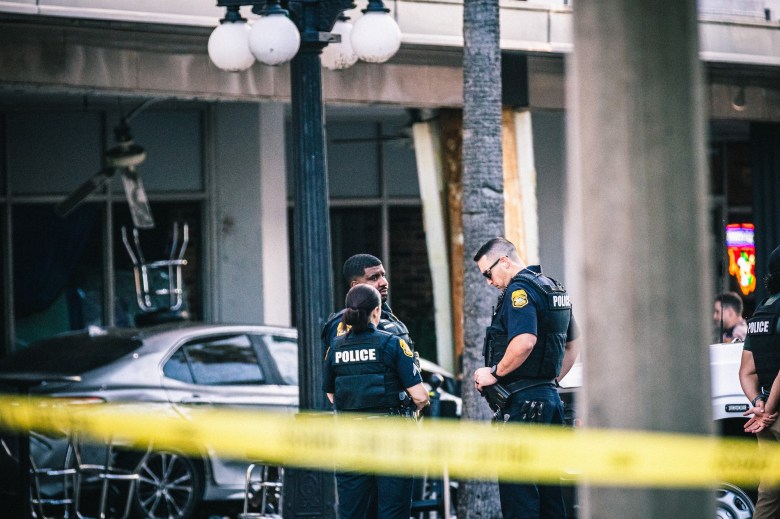 Bradley’s on 7th in Ybor City, Florida on Nov. 8, 2025. Credit: Dave Decker / Creative Loafing Tampa Bay
Bradley’s on 7th in Ybor City, Florida on Nov. 8, 2025. Credit: Dave Decker / Creative Loafing Tampa Bay
Community members gathered outside Bradley’s on 7th in Ybor City on Saturday night to mourn the four lives lost when a high-speed chase ended with a car crashing into a popular LGBTQ nightclub . Many had questions about how the crash happened in the first place.
Florida Highway Patrol (FHP) pursued a vehicle down Ybor City’s E 7th Avenue, known for its weekend nightlife, around 12:30 a.m. early Saturday morning. The vehicle, which had allegedly been used for street racing earlier that night, swerved to avoid a turning vehicle and crashed, killing four people and injuring 13 others outside of Bradley’s on 7th. Advocates for safer police pursuits say this was a poorly-executed chase that prioritized apprehension of a nonviolent criminal over public safety.
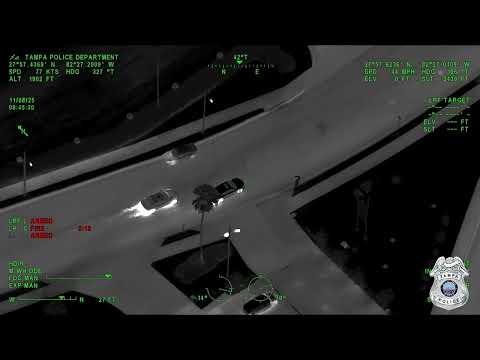
Video provided by the Tampa Police Department shows a FHP vehicle attempting a PIT (precision immobilization technique) maneuver—in which the pursuing vehicle attempts to cause the pursued vehicle to spin out of control—near Chapo’s Tacos, about 2,000 feet from Bradley’s.
When the maneuver fails, the FHP vehicle pursues another thousand feet before abandoning the chase shortly after the intersection of Nuccio Parkway and 7th Avenue where the Ybor City gateway arch greets visitors.
“They’re gonna be GOA on this,” a voice says over the police radio in the video as an FHP vehicle attempts the PIT maneuver. GOA, or “gone on arrival,” refers to a situation where a suspect has fled the scene by the time police arrive.
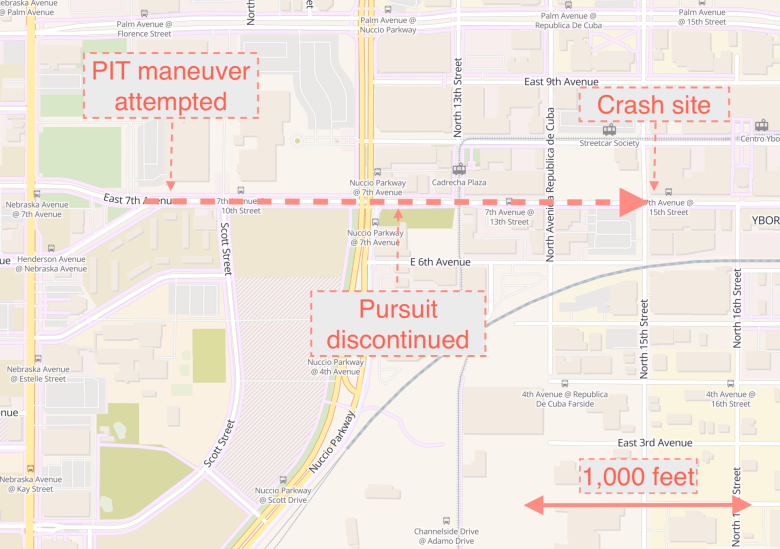 An OpenStreetMap showing key moments in the fatal high-speed chase that killed four people in Ybor City, Florida on Nov. 8, 2025. Credit: Date obtained and annotated by Valerie Smith / Map generated with OpenStreetMap
An OpenStreetMap showing key moments in the fatal high-speed chase that killed four people in Ybor City, Florida on Nov. 8, 2025. Credit: Date obtained and annotated by Valerie Smith / Map generated with OpenStreetMap
Creative Loafing Tampa Bay analyzed the footage by marking the approximate location of the vehicle at each second during the video, then measuring the distance between those points to determine the speed. CL estimates that the pursued vehicle was traveling between 70–80 miles per hour when the pursuit ended, per aerial video, and between 50–60 miles per hour when the vehicle crashed, per security camera video.
If the pursued vehicle was traveling 60 miles per hour on average between the end of the chase and the crash, this would mean that the crash occurred roughly 12 seconds after the pursuit was terminated by FHP. Video of the time between the discontinuation of the pursuit and the crash has not yet been released by the Tampa Police Department.
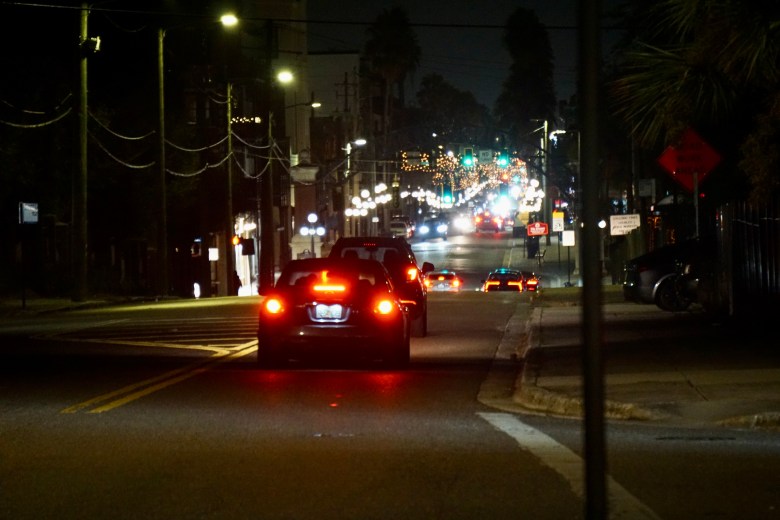 The car in the foreground is approximately where, on Nov. 8, 2025, an FHP officer attempted a PIT maneuver between 70–80 miles per hour, per CL estimates. Credit: Valerie Smith / Creative Loafing Tampa Bay
The car in the foreground is approximately where, on Nov. 8, 2025, an FHP officer attempted a PIT maneuver between 70–80 miles per hour, per CL estimates. Credit: Valerie Smith / Creative Loafing Tampa Bay
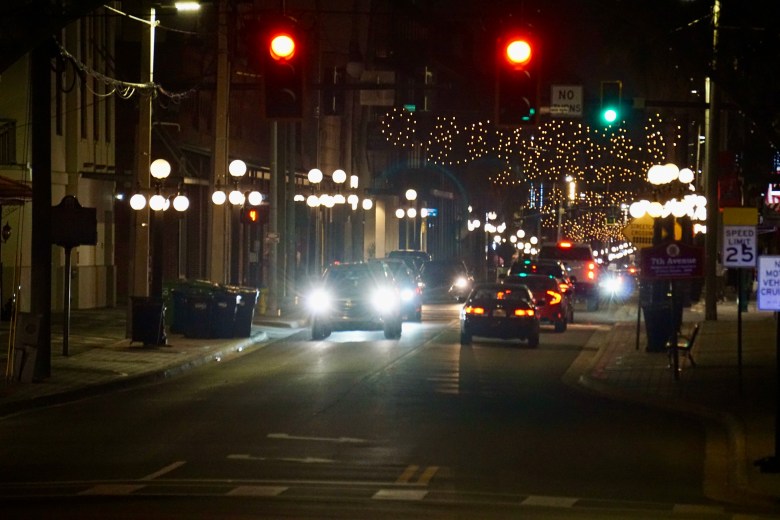 The traffic light in the foreground is approximately where FHP officers discontinued pursuit on Nov. 8, 2025. Credit: Valerie Smith / Creative Loafing Tampa Bay
The traffic light in the foreground is approximately where FHP officers discontinued pursuit on Nov. 8, 2025. Credit: Valerie Smith / Creative Loafing Tampa Bay
FHP’s pursuit policy was relaxed in 2024, contravening national policy expert recommendations by expanding situations in which a chase is allowed and giving the officers driving the vehicles more discretion over how to conduct the chase.
TCPalm reporter Jack Lemnus recently spent over a year collecting and analyzing FHP chase data and public records. He found that FHP chase-related deaths tripled and use of PIT maneuvers doubled after the agency changed its policy to allow for higher-risk tactics.
Tom Gleason is a retired police officer and law enforcement trainer and is an expert in safe police pursuit. He told CL that giving officers that much control can result in clouded judgement over potentially-lethal public safety threats. “The deputies get so emotionally involved in a pursuit that they have difficulty letting it go,” Gleason told CL.
Gleason, who is a member of safer pursuit advocacy group PursuitSafety (stylized “PursuitSAFETY”), told CL that four main violations of sensible chase policy occurred: pursuit was initiated for a nonviolent crime, ground pursuit occurred after a helicopter had sight of the vehicle, a PIT maneuver was attempted at over 40 miles per hour, and the pursuit was taken to a populated area.
A 2023 guide published by the Police Executive Research Forum (PERF) and the U.S. Department of Justice recommends that pursuits be initiated “only for violent crimes and where failure to immediately apprehend the suspect presents an imminent threat to the public based on the suspect’s criminal actions (not the danger created from the suspect’s driving as they flee from police).” FHP does not have strict guidelines on when pursuit is permitted, and leaves the decision to chase up to the discretion of the pursuing officer. Chasing when it isn’t necessary, Gleason said, puts innocent bystanders at risk.
PERF’s guide also says that once aerial surveillance is established, ground pursuit should be discontinued. This keeps police out of the pursued driver’s sight, which will often cause the driver to slow down and eventually stop, at which point officers may establish a perimeter and apprehend the offender. It is unclear why the FHP vehicle initiated a ground pursuit when a helicopter was already tracking the pursued vehicle.
Gleason told CL that when he was a PIT instructor, he was told that PITs were only to be used at 40 miles per hour or less, and anything greater was considered deadly force because vehicles are unpredictable at high speeds.
It is unclear why the pursuit continued as far as it did. Standing at the location where the FHP vehicle is last seen in the aerial video, this reporter was able to see the Bradley’s sign. Previous information provided by police did not clarify how close the FHP vehicle was to the crash when pursuit was discontinued, initially saying the PIT maneuver occurred before Nebraska Avenue, despite aerial video showing otherwise.
“The original offense was nothing more than a speeding offense,” Gleason told CL. “FHP will use the excuse, ‘We do it for public safety.’”
He said that the “excuse” of public safety is inappropriate when initiating a pursuit of a nonviolent offender, and that police have a responsibility to not add to the danger created by a fleeing vehicle. The FHP’s policy on pursuit also says that pursuing officers “should avoid contributing to the danger that has already been created by the fleeing violator or other hazardous situations when in emergency response.”
FHP did not tell CL whether or not the officer involved in the incident will face disciplinary measures.
“Is our action adding to public safety, or is it taking away by adding risks to the general public?” Gleason asked, referring to a speeding vehicle as “a 3,000 pound bullet” due to its ability to rapidly injure or kill multiple people at a time.
He also warned that even the best-trained officers should avoid pursuit whenever possible, because they cannot predict the outcome: “The guy driving the car that you’re chasing is not trained.”
Subscribe to Creative Loafing newsletters.
Follow us: Google News | NewsBreak | Reddit | Instagram | Facebook | BlueSky
This article appears in Nov. 6 – 12, 2025.
Related

